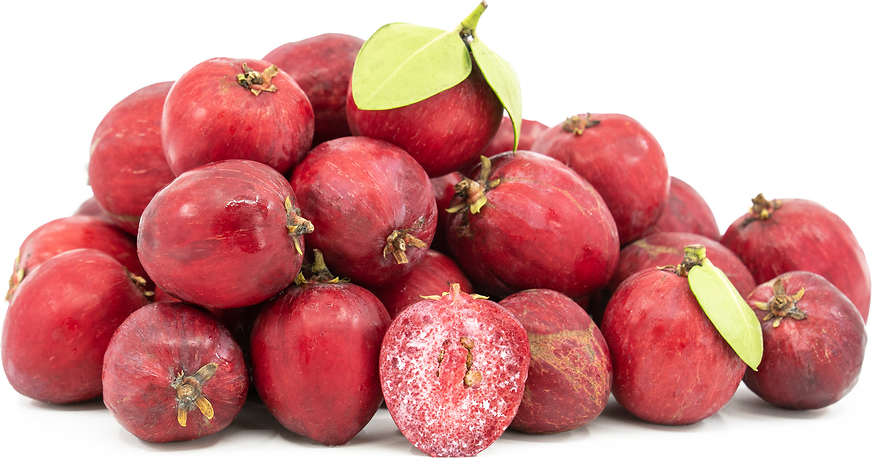


Natal Plums
Estimated Inventory, lb : 0
Description/Taste
Natal plums are small, rounded fruits with a tapered point. They are about the size of a kumquat, measuring 2.5 to 5 centimeters in length and 2.5 to 4 centimeters in diameter. Their skin is a deep red, resembling a pomegranate, and is smooth and glossy. When cut, the red-fleshed interior releases flecks of milky white sap and has a juicy texture similar to a common plum. The flesh also encases brown oval-shaped seeds, each about the size of a small almond. Natal plums emit a sweet, subtly floral scent akin to jasmine or orange blossoms and are edible raw. Their taste combines the tartness of cranberries with the sweetness of apples and strawberries.
Seasons/Availability
Natal plums first appear in the summer and can grow throughout the winter in warmer, frost-free climates.
Current Facts
Natal plums, botanically known as Carissa macrocarpa, are native to South Africa and belong to the Dogbane family. The fruits grow on plants with vivid green branches and leaves and are adorned with white flowers and double-pronged thorns. Natal plums are primarily eaten raw or utilized in culinary applications, such as making jams or jellies. The fruits are curiously referred to as "large num-nums” in South Africa and were once a staple ingredient for various South African tribes, including the Zulu people, who represent the largest ethnic group in the country today. However, its consumption declined after the 1600s with the introduction of imported products by colonists, localizing Natal plums to their native growing regions.
Nutritional Value
Natal plums are rich in vitamins A and B and extremely high in vitamin C, exceeding that of citrus fruits. These vitamins support immune function, maintain skin health, enhance vision, and promote a healthy nervous system. Natal plums have significant calcium, magnesium, and phosphorus levels that may contribute to strengthening bones, improving muscle function, and boosting energy metabolism. In traditional African medicine, Natal plums are eaten to ward off colds and flu, and their leaves are boiled to be used as a poultice for toothaches. The roots have also been employed to remedy inflammation, aches, chest pain, and malaria.
Applications
Raw Natal plums can be eaten right off the branch, sliced into salads, or used as cake toppings. They can also be cooked in pies, breads, jams, sauces, and soups or even pickled with a mix of masala, lemon juice, and oil. Only the fruit of the Natal plum plant is safe to eat. As a cousin to the toxic Oleander, its stems and leaves are poisonous and should be avoided. Natal plums can be substituted for fresh cranberries in recipes. They blend well with a variety of flavors, including apples, raisins, spinach, citrus, grapes, pomegranates, pecans, and walnuts. Natal plums are best stored in the refrigerator, where they can last for a week.
Ethnic/Cultural Info
Natal plum plants are widely utilized for their security benefits, attributed to their dense foliage and prominent thorns. It has naturally evolved sharp, twice-forked spines, a strategic adaptation to safeguard its fruit from consumption by elephants and other large game. Beyond its protective role, Natal plums are used globally as an ornamental hedge, valued for their fragrant flowers that evoke the scent of Hawaiian gardenias. One of the most well-known uses of Natal plum trees in the United States can be seen in the landscape of Disneyland. The tree is found in Tomorrowland and is a part of the land’s theme of having all edible plants as decorative elements. It is important to note that plants regularly get cycled in and out of the landscape at the theme park, so the edibility claim may no longer be true across all of the plants, but the Natal plum tree produces edible fruits that are favored for their vibrant red coloring to enhance the overall environment of the theme park.
Geography/History
In Africa, Natal plums are widespread, ranging from Senegal to Sudan and Ethiopia south to their native South Africa. They also grow in California, Hawaii, Florida, the Bahamas, the Philippines, and the subtropical zones of India. Adapted to sandy soils and saltwater, Natal plums flourish in sand dunes and coastal forests with warm climates. Natal plums were introduced to the United States in the late 1800s, with thousands of seedlings later cultivated at the Plant Introduction Garden in Miami and spread across Florida, Mississippi, Alabama, Louisiana, Texas, and California. The fruit also made its way to Hawaii in the early 1900s. Currently, their commercial availability is primarily confined to regions where they grow naturally. In these regions, Natal plums are primarily found through foraging, though they can sometimes be found through local markets and specialty stores.
Recipe Ideas
Recipes that include Natal Plums. One
| Dee’s Kitchen |
|
Karonde Ka Achaar (Natal Plum Pickle) |
| The Culinary Linguist |
|
Amatungulu Jam |
| Vegetarian Tastebuds |
|
Karonda Murabba / Natal Plum Sweet Preserve |
Podcasts




